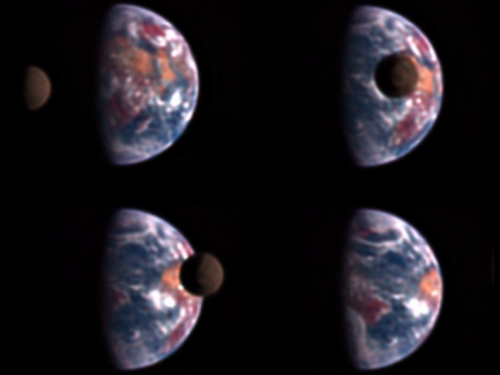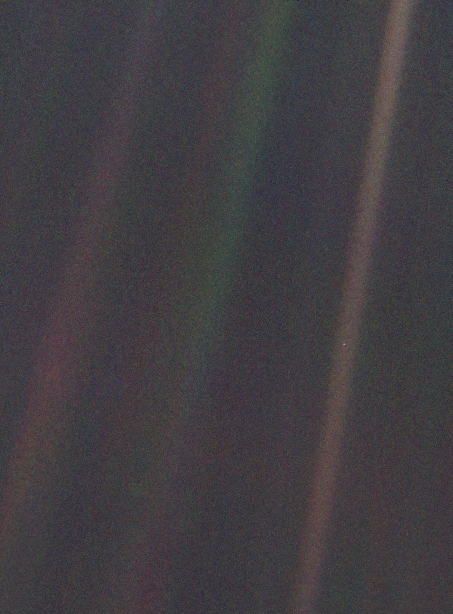Although we’ve seen spectacular images from deep space with the help of Voyager, New Horizons and numerous other spacecraft, the view from 1 million kilometers out can still put our world in perspective. Below is what a CubeSat called Mars Cube One (MarCO-B), one of a pair of such diminutive spacecraft, saw from that distance as it turned its camera back toward Earth. At the sides of the image you can see bits of the thermal blanket, the high-gain antenna feed and the HGA itself at the right, but in the center is the place we call home, the Earth-Moon system. You may want to zoom in to see the Moon better.
Image: The first image captured by one of NASA’s Mars Cube One (MarCO) CubeSats. The image, which shows both the CubeSat’s unfolded high-gain antenna at right and the Earth and its moon in the center, was acquired by MarCO-B on May 9. Credit: NASA/JPL-Caltech.
I’ve been keeping an eye on the MarCO CubeSats because they are the first of their type to be sent into deep space. The intention is to use them to relay data about the InSight Mars lander; the CubeSats are a technology demonstration that will help us clarify their future uses. The science will be carried out by InSight itself (Interior Investigations Using Seismic Investigations, Geodesy and Heat Transport) on the Martian surface, so this CubeSat image is a bonus.
It’s also a fine perspective changer, of the sort the space program has provided us throughout its history. So many people have seen and been moved by the famous Bill Anders photo of Earthrise from Apollo 8 that I almost don’t have to show it, but then again, how could I not, given that it still puts a shiver up my spine? The image was taken on December 24, 1968, a Christmas Eve that was immortalized by the Apollo 8 crew’s reading of the opening lines of Genesis. The crew also had this bit of banter about the acquisition of the image:
Anders: Oh my God! Look at that picture over there! There’s the Earth coming up. Wow, is that pretty.
Borman: Hey, don’t take that, it’s not scheduled. (joking)
Anders: (laughs) You got a color film, Jim? Hand me that roll of color quick, would you…
Lovell: Oh man, that’s great!

Great indeed. The Earthrise image has been declared “the most influential environmental photograph ever taken” (by photographer Galen Rowell) and inspired countless people including this writer, who had an enormous poster of it on his bedroom wall. Perspectives normally shift slowly, but in the era of space photography, perspective jumps can be startling, offering the planet the opportunity to see itself with fresh eyes. The reprocessed 1966 photo from the robotic Lunar Orbiter 1 wasn’t released by NASA until 2008, but even in its black and white form (and at lower original quality), it could also have triggered such a shift.

Image: This restored old image of Earth was released by NASA in 2008. The Lunar Orbiter 1 spacecraft took the iconic photograph of Earth rising above the lunar surface in 1966. Using refurbished machinery and modern digital technology, NASA produced the image at a much higher resolution than was possible when it was originally taken. Credit: NASA, Lunar Orbiter Image Recovery Project.
The thing about space exploration is that the wonders just keep coming, which invariably gets me to New Horizons and the image that provided my most recent perspective jump. Here we’re seeing the beautiful blue of Pluto’s haze layer through the New Horizons Multispectral Visible Imaging Camera (MVIC).
But of course the perspective jolt is in realizing that we’re seeing Pluto from behind. The Voyagers have traveled much farther than this, but not past Pluto, which for me had always been symbolic of the system’s ‘edge.’ To be looking at sunlight coming through its atmosphere from behind after the close flyby was an almost surreal experience.

Image: The high-altitude haze at Pluto is thought to be similar in nature to that seen at Saturn’s moon Titan. The source of both hazes likely involves sunlight-initiated chemical reactions of nitrogen and methane, leading to relatively small, soot-like particles (called tholins) that grow as they settle toward the surface. This image was generated by software that combines information from blue, red and near-infrared images to replicate the color a human eye would perceive as closely as possible. Credit: NASA/JHUAPL/SwRI.
One more perspective changer takes us back toward Earth. It’s from the Deep Impact spacecraft, now re-purposed as EPOXI, a double-mission comprised of the Deep Impact Extended Investigation (DIXI) and Extrasolar Planet Observation and Characterization (EPOCh). Here again we’re looking at Earth and its Moon in a series of images showing the passage of the Moon between us and our planet. You’ll find more on EPOCh especially in the archives here, for the spacecraft has been used not only to study exoplanets but also to examine the Earth to help characterize planets like ours for future missions.

Image: Four images from a sequence of photos taken by the Deep Impact spacecraft when it was 50 million km from the Earth. Africa is at right. Notice how much darker the moon is compared to Earth. It reflects only as much light as a fresh asphalt road. Credit: Donald J. Lindler, Sigma Space Corporation, GSFC, Univ. Maryland, EPOCh/DIXI Science Teams.
But you knew the medievalist in me couldn’t resist pulling a far older reference on perspective into the picture. Below is one of the earliest paintings to use linear perspective, the work of Florentine artist known as Masaccio (1401-1428). It may not seem to have much in common with space missions, but consider this: The development of perspective in painting was the emergence of a far more realistic depiction of people amidst buildings and landscapes, a style that would be known as Florentine Realism and would fundamentally change visual art. How we look at ourselves in the world influences the values and character of a civilization.

Images cause us to see ourselves with fresh eyes, and in the spectacular imagery of our space missions, we get a gut-check on our place in the universe. Some people say that the famous ‘pale blue dot’ image made us realize how insignificant we are, but I have a much different take. The Voyager image below, taken when Voyager was 6 billion kilometers from home, shows Earth as a speck barely visible in the brown band to the right. When I look at it, what I see is that we are a species that was able to get out there and look back upon its own home world.
Going to other planets, going to the stars — there is nothing inevitable in any of this. These are choices we make, within the context of our values and our science. Images like these remind us how momentous our choices are.

Image: This narrow-angle color image of the Earth, dubbed ‘Pale Blue Dot’, is a part of the first ever ‘portrait’ of the solar system taken by Voyager 1. The spacecraft acquired a total of 60 frames for a mosaic of the solar system from a distance of more than 6 billion kilometers from Earth and about 32 degrees above the ecliptic. From Voyager’s great distance Earth is a mere point of light, less than the size of a picture element even in the narrow-angle camera. Earth was a crescent only 0.12 pixel in size. Coincidentally, Earth lies right in the center of one of the scattered light rays resulting from taking the image so close to the sun. This blown-up image of the Earth was taken through three color filters – violet, blue and green – and recombined to produce the color image. The background features in the image are artifacts resulting from the magnification. Credit: NASA/JPL-Caltech.
The MarCO team also has the ‘pale blue dot’ in mind, pointing to its own Earth/Moon image:
“Consider it our homage to Voyager,” said Andy Klesh, MarCO’s chief engineer at NASA’s Jet Propulsion Laboratory, Pasadena, California. JPL built the CubeSats and leads the MarCO mission. “CubeSats have never gone this far into space before, so it’s a big milestone. Both our CubeSats are healthy and functioning properly. We’re looking forward to seeing them travel even farther.”
The pale blue dot fills me with humility but also an exhilarating sense of the human drive to explore. And that brings me back to New Horizons, now closing on the Kuiper Belt Object MU69. ‘Ultima Thule,’ as it is known by the New Horizons team, is only about 30 kilometers in diameter and seems to be a close binary. On January 1, 2019 we will have a flyby of this object, the farthest ever to be visited by a spacecraft. Who knows what perspective changes that imagery may trigger?




Wouldn’t it be something if MU69 is a close binary, and the flyby geometry permits New Horizons to take an “un-Sun-dazzled” picture of the Earth–from behind the dual-crescents MU69, with the Earth seen *between* the two components…? Also:
I wonder if that back-lit picture showing Pluto’s atmospheric haze is as it would look in person, to someone actually in that position? It just seems that the sunlit haze layer should be much dimmer, given the Sun’s tremendous distance from Pluto (just as most pictures showing both the Earth and the Moon have the Moon’s apparent brightness “turned up” because it’s so dark; if such a picture used a long enough “natural” exposure to show the Moon well, the much brighter Earth would be so over-exposed that it would look as dazzling–and featureless–as Venus!), and:
Thank you for posting the picture from the MarCO-B “CubeProbe!” It and MarCO-A (unofficial nicknames of “Marco” and “Polo” seem natural for MarCO-A and MarCO-B… :-) ) are *satellites* of the Sun, of course, but even a dedicated Sun-observing solar orbiter (or a Moon-studying flyby or orbiter spacecraft) of CubeSat design–and certainly planetary flyby spacecraft such as the two MarCO probes–ought to have a technical descriptor that reflects their more-than-Earth-satellite missions.
What would Earth’s magnitude be from that distance? And Sol’s for that matter? Would our planet just be too close to the sun to be splitable/visible with NH’s cameras?
I forgot, there is a plan to do a Pale Blue Dot with New Horizons:
https://www.theatlantic.com/science/archive/2018/02/new-horizons-pale-blue-dot-nasa/553160/
To quote:
“We’ve been talking about it for years,” says Andy Cheng of the plan to take another ‘Pale Blue Dot’ image. Cheng is a scientist at Johns Hopkins University’s Applied Physics Laboratory and the principal investigator for LORRI.
It’s a risky move. The attempt requires pointing LORRI close enough to the sun so that objects in the darkness are illuminated, but not so close that sunlight damages or destroys the camera.
“But we’re going to do it anyway, for the same reason as before,” Cheng says. “It’s just such a great thing to try.”
The photo shoot will take considerable coordination. “All activities on the spacecraft need to be choreographed in elaborate detail and then checked and checked again,” Cheng says. “Taking a LORRI image involves more than just LORRI—the spacecraft needs to point the camera in the right direction, LORRI needs to be operated, the image data needs to be put in the right place and then accessed and transmitted to Earth, which requires more maneuvers of the spacecraft, all of which needs to happen on a spacecraft almost 4 billion miles away.”
At that distance, our home in the universe will look tremendously small. “It’ll be very hard to pick out that tiny, bright dot,” he says.
Imagining Kuiper Belt Object MU69 to be an ancient, extremely advanced sentinel device… SETI, METI etc. might be re-organized.
As the following article was posted in 2005, has anyone actually gone and conducted an IR hunt for artificial KBOs yet?
https://centauri-dreams.org/2005/09/01/an-infrared-hunt-for-artificial-kuiper-belt-objects/
The outer comet belts might be the ideal place for interstellar civilizations to set up shop:
https://centauri-dreams.org/2013/02/19/interstellar-expansion-colonizing-ice-dwarfs/
I can see the Earth but not the Moon in the Mars Cube One picture.
You’ll have to blow up the image by clicking on it to see the Moon.
Thank you very much for such a refreshing morning jog through your mind sir. I think what I am feeling is … elation, yes that’s it, very much indeed.
If the article brought about elation, I’m very pleased! Thanks for commenting.
These photographs really do give a taste for the immensity of the size of space like the MarCO CubeSats and pale blue dot photo. The Moon is roughly thirty Earth diameters apart, but it gets squashed by the fifty million mile distance from the EPOXI to look like an Earth-Moon size comparison.
Paul, I think this so often when I read your articles: thank your for your optimism and hope. I find it difficult to generate such views of my own, I’ve become jaded and at times I feel as if I’m suffocating in my pessimism. But when I read your works, infused with your optimism, it is like breathing pure O2. Thanks.
Thank you, Erik. That’s heartening to me, and I’m pleased that these articles have that effect. We all get jaded at times — I certainly do — but I’m convinced that the best response is to redouble our efforts toward worthwhile goals. Glad to have you as a reader.
On seeing the Earth for the first time
What would it be like to finally be able to see the Earth from the outside, as a world floating in the darkness of space? In an essay excerpted from his new book, Christopher Potter discusses those efforts to see the Earth as it truly is, from space.
Monday, April 9, 2018
http://thespacereview.com/article/3470/1
Review: The Earth Gazers
Images of the Earth from space are commonplace today, but a half-century ago those first views of the Earth as a sphere in the void stunned society. Jeff Foust reviews a book that examines imagery from space within the context of a history of spaceflight.
Monday, April 9, 2018
http://thespacereview.com/article/3467/1